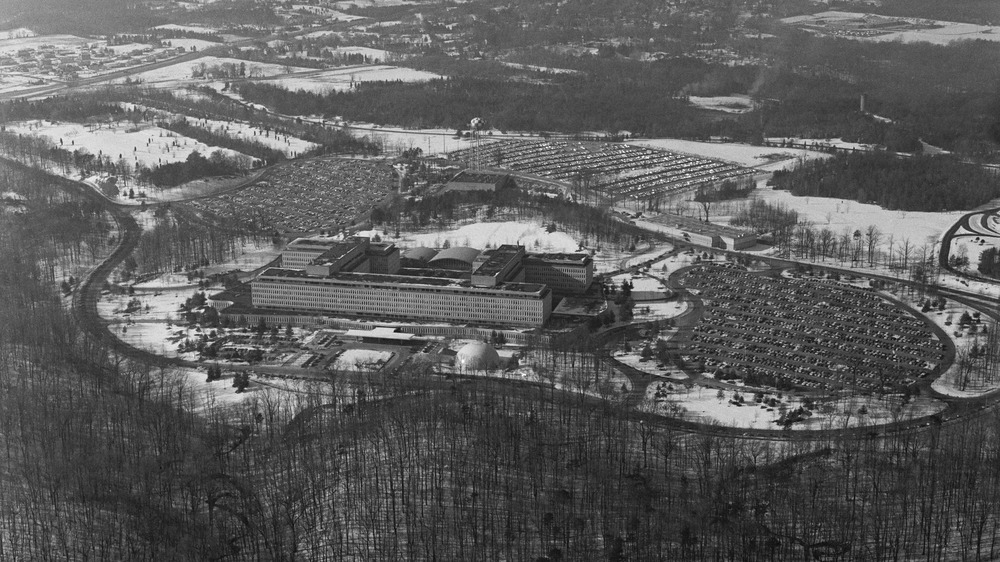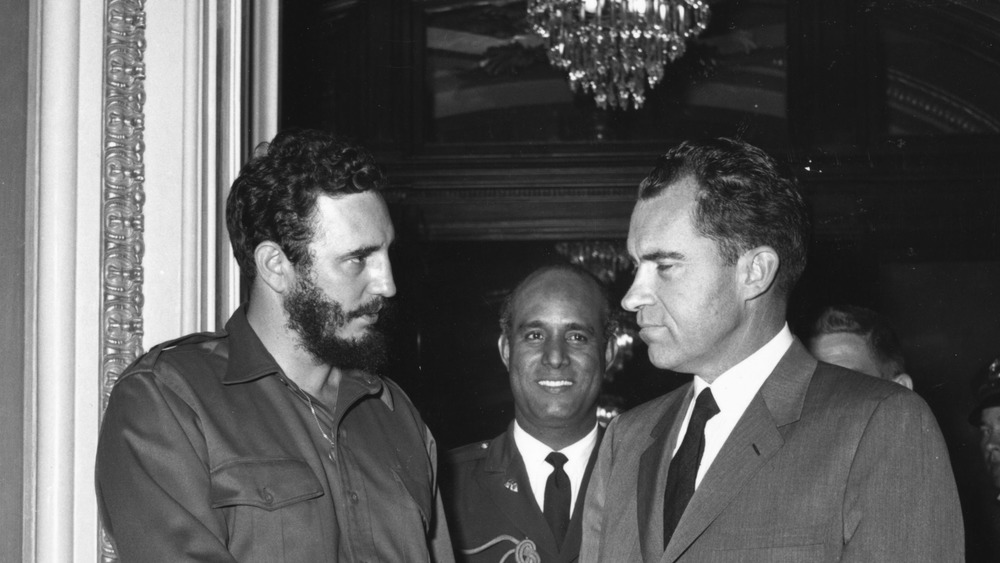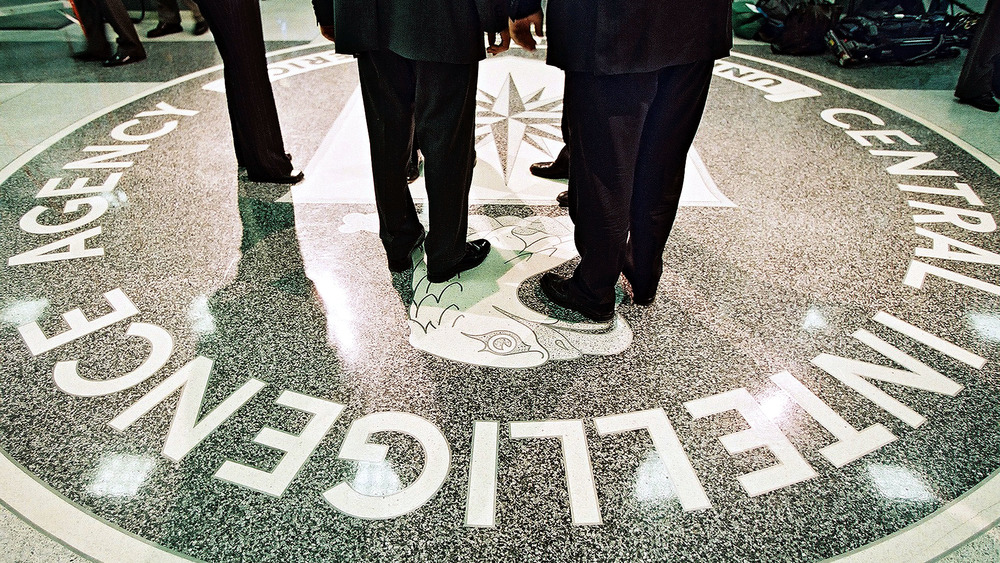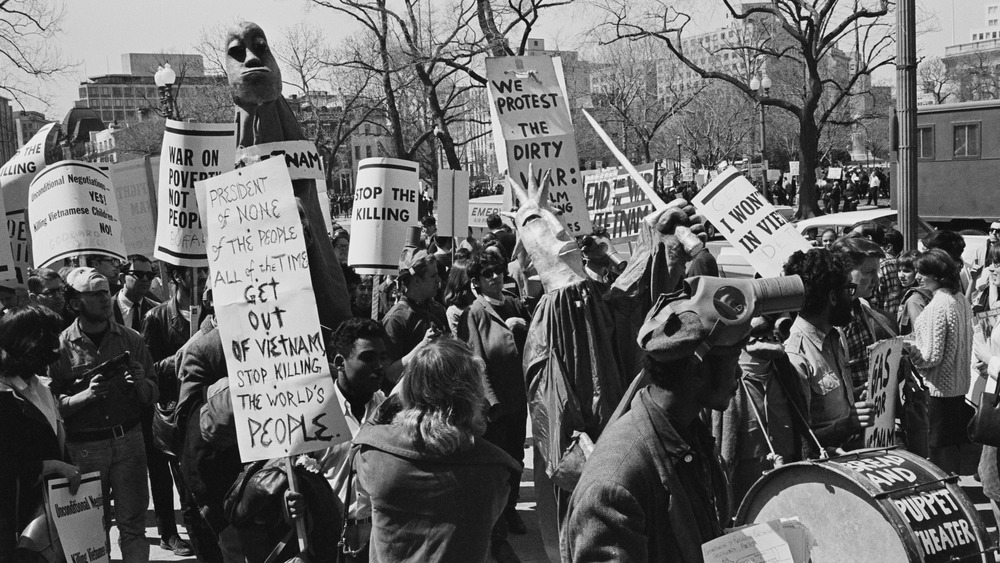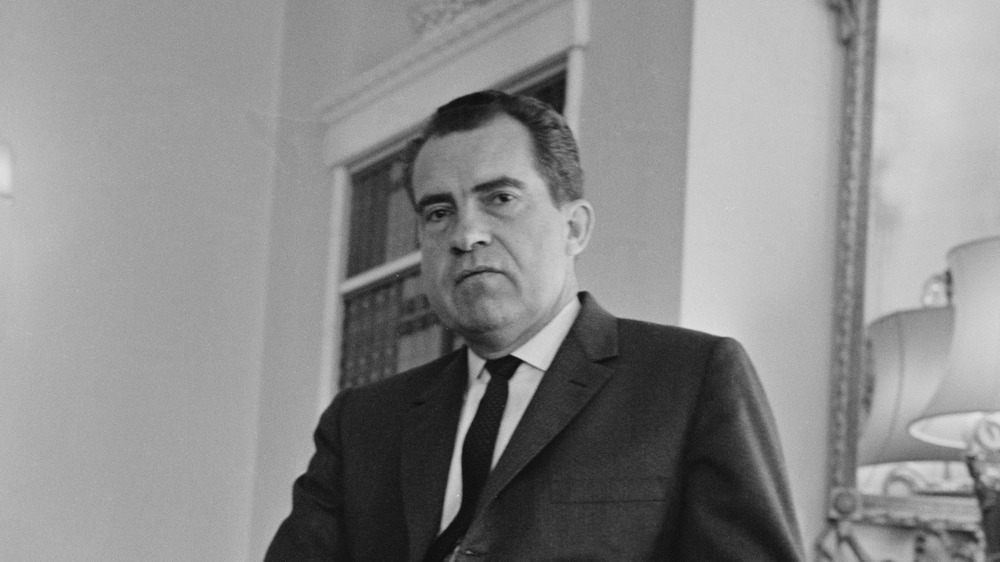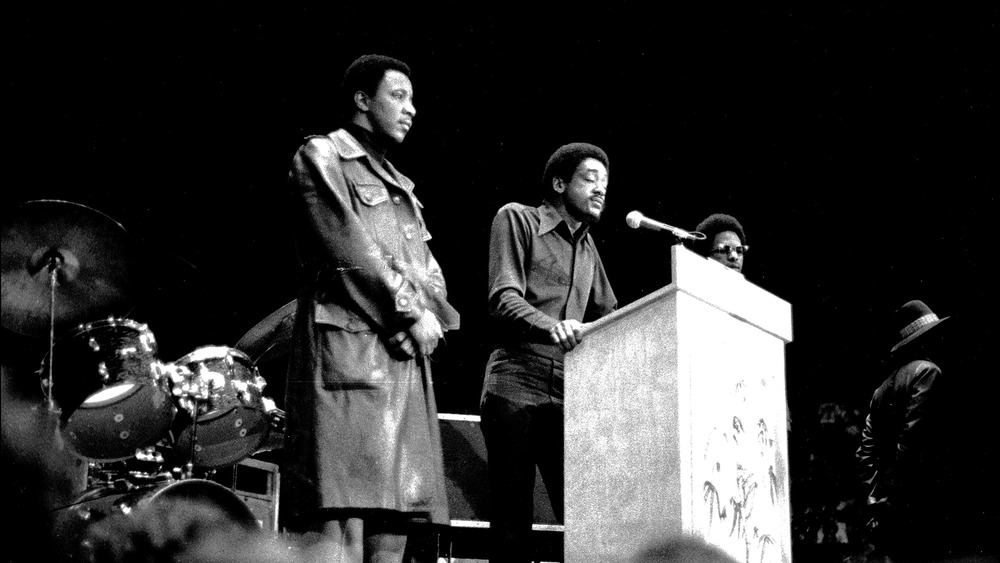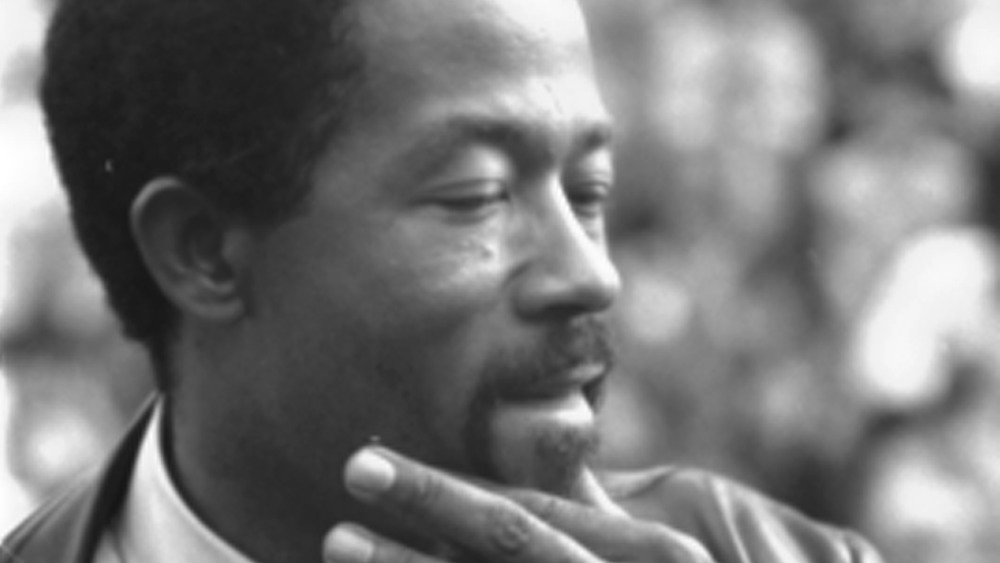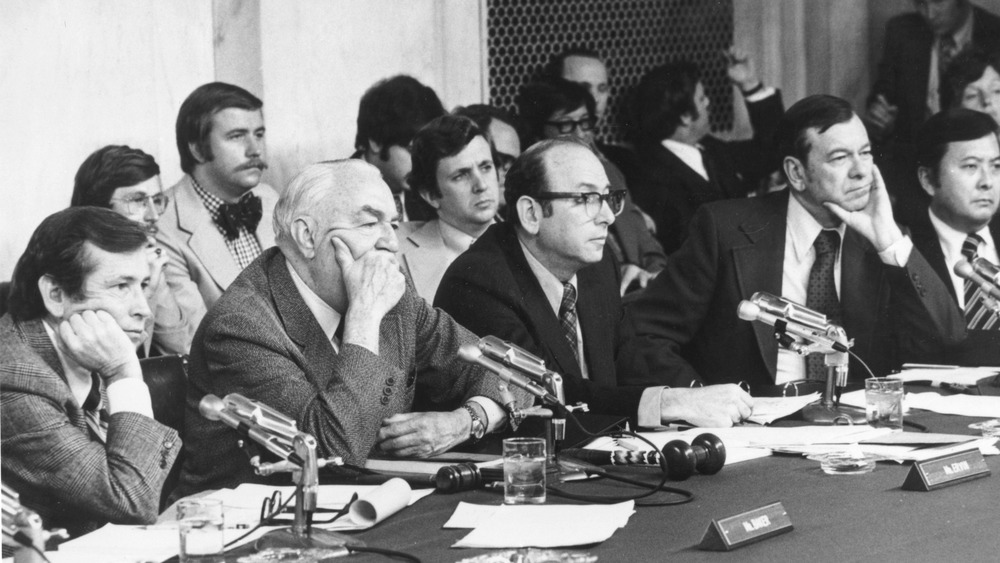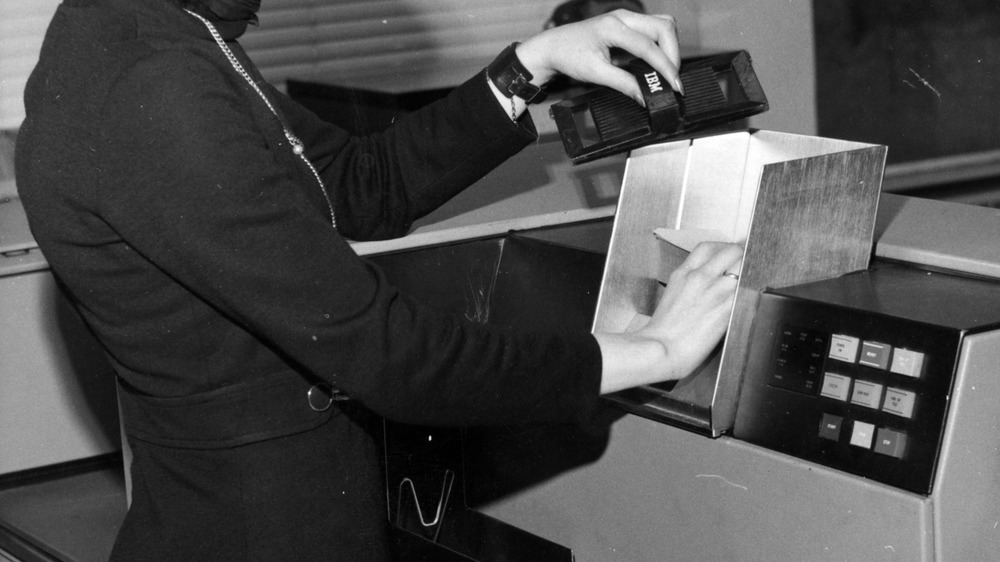Operation CHAOS: The CIA Program That Spied On Americans
The CIA has engaged in so much illegal and absurdist activity that sometimes it's difficult to discern fact from conspiracy. Did the CIA experiment with LSD as a mind-control substance? Absolutely. Did the CIA create HIV/AIDS? Nope, that was actually a disinformation campaign by the KGB, nicknamed "Operation INFEKTION" by historian Thomas Boghardt.
One of the illegal things the CIA did do is engage in domestic espionage and target people in the United States. At the very least, this activity occurred from 1964 to 1974, but actual the start and end dates are foggy. Intelligence was compiled on over 300,000 people, with individual files on over 7,000 U.S. citizens.
Operation CHAOS compiled a number of the CIA's illicit activities and was soon feeding information to the FBI's equally suspect COINTELPRO. Anti-war protestors and Black Panther Party members were targeted, while journalists were added to the CIA's payroll. Meanwhile, the CIA and the FBI went almost 400% over budget with these activities compared to what they told Congress they were spending. This is Operation CHAOS, the CIA program that spied on Americans.
Cuban exiles and the CIA
The origins of the CIA's venture into domestic espionage date back to January 1959, when Fidel Castro assumed power over Cuba. President Dwight D. Eisenhower responded with disdain, even refusing to meet with a Cuban delegation in April 1959. By March 1960, Eisenhower took the CIA up on their recommendation to "sound out" and organize Cuban exiles who were fleeing after Castro's victory.
According to "The History of Operation CHAOS," by Verne Lyon, since many of the exiles were considered "wealthy educated professionals [who were] looking for a sympathetic ear in the United States," the CIA started actively recruiting contacts to be used against Castro in the future. During this time, the CIA also started training and equipping Cuban exiles in bases in southern Florida, Panama, and Guatemala. At the time however, the State Department claimed to know "absolutely nothing" about the training bases.
Although this was by all definitions illegal, FBI Director J. Edgar Hoover accepted it as a "legitimate CIA function." The CIA simply considered this activity an extension of their "authorized infiltration of dissident groups abroad," despite the fact that now this activity was taking place in the U.S.
In theory, the CIA's power is limited, and they're prohibited from "U.S. operations" and aren't allowed to surveil anyone considered a "U.S. Persons," which includes legal immigrants, resident aliens, corporations, and citizens.
Creation of the Domestic Operations Division
In 1963, President Lyndon B. Johnson allowed CIA Director John McCone to create a new branch of the CIA called the Domestic Operations Division (DOD). According to declassified documents on the CIA, the mission of the DOD was to "exercise centralized responsibility for the direction, support, and coordination of clandestine operational activities of the Clandestine Services conducted within the United States against foreign targets."
Neither the CIA, nor Johnson, nor J. Edgar Hoover informed Congress about the creation of the DOD. According to "The History of Operation CHAOS," the very name of the branch "mocked the explicit intent of Congress to prohibit CIA operations inside the U.S," but if Congress didn't know about it, then they couldn't possibly regulate or impede it.
One of the things that the new division of the CIA was involved in was using "literature as an anti-Communist weapon," subsidizing books that the CIA wanted Americans to be reading, even travel books. The division was headed by Charles Tracy Barnes, who oversaw the 1954 coup in Guatemala and included people such as E. Howard Hunt, one of the future conspirators of Watergate.
Student protests against Vietnam
In 1965, both President Lyndon B. Johnson and J. Edgar Hoover were certain that communist forces were manipulating student protests against the Vietnam War. And since Hoover assured Johnson that international communism was responsible, the CIA was asked to confirm the allegation.
According to "The History of Operation CHAOS," the DOD's intelligence operations began to expand, with orders to collect information on university and college campuses. Other than "don't get caught," there were no further guidelines. Countless people were sent to universities and colleges across the country to become the "eyes and ears" of the CIA. Sometimes, their surveillance wouldn't even be work-related. Verne Lyon, a former CIA operative stationed at Iowa State University, admitted that he initiated a file on a young woman because she refused a date with him.
Eventually codenamed Operation CHAOS — (sometimes MHCHAOS) as the illegal surveillance operation grew — over the course of seven years, information was gathered on over 300,000 people. However, the CIA would never be able to prove communist involvement in the demonstrations against the Vietnam war.
Projects RESISTANCE, MERRIMAC, and HT/LINGUAL
There were three main projects that involved illegally surveilling people in the U.S. — Projects RESISTANCE, MERRIMAC, and HT/LINGUAL.
The CIA's infiltration of universities and colleges was part of Project RESISTANCE, under which the CIA sought "active cooperation from college administrators, campus security, and local police to help identify antiwar activists, political dissidents, and 'radicals.'" According to "Anglo-American Privacy and Surveillance," by Laura K. Donohue, as a result of Project RESISTANCE, over 12,000 people, most of whom were students, were brought under surveillance.
Project MERRIMAC was focused on monitoring anti-war organizations, such as the Women's Strike for Peace and Students for a Democratic Society, as well as Black activist groups. While the initial scope of the program was to "obtain early warning of demonstrations and other physical threats to the CIA," it was soon broadened to include information about funding, leadership, and activities of various targeted groups. Under the scope of these two projects, the CIA assisted police departments in countless "illegal, warrantless searches of private properties."
Project HT/LINGUAL was established in 1952, with the CIA taking full authority in 1955. Project HT/LINGUAL was a mail intercept program for mail sent between the U.S. and the Soviet Union, and it's unclear exactly how many letters were intercepted and how many people were under surveillance as part of Project HT/LINGUAL. According to a hearing on the CIA Exemption in the Privacy Act of 1974, it's also unclear what happened to the watch lists after the mail intercept program was dissolved.
Operation CHAOS
In July 1968, all of the CIA's domestic intelligence operations were consolidated under one program titled Operation CHAOS. Richard Ober was placed in charge, and under the direction of President Lyndon B. Johnson, Operation CHAOS's activities were expanded.
According to CIA Intelligence Collection about Americans, even the FBI supplied reports to Operation CHAOS, sometimes at a rate of "over 1,000 a month." Ironically, Johnson had originally wanted the CIA's intelligence "in order to compare it with that provided by the FBI."
Information regarding Operation CHAOS however, was tightly controlled. Cable traffic was only seen by "few high-level officials," with tight security maintained even within CHAOS itself. And those involved were entirely aware of how illegal their activity was. According to the 1975 Rockefeller Commission Report, a memorandum from CIA Director Richard Helms on Feb. 18, 1969, emphasized how "extremely sensitive" a report on student activities was, and that "should anyone learn of its existence it would prove most embarrassing for all concerned."
Richard Nixon expands Operation CHAOS
By the time President Richard Nixon took office in January 1969, there were over 50 CHAOS agents. Many went overseas for weeks on end to train and establish a cover as radicals and enrolled in universities and colleges upon returning home.
In June 1970, the International Committee on Intelligence (ICI) was created because Nixon wanted a "coordinated and concentrated effort against domestic dissenters." Chaired by J. Edgar Hoover, the first report of the ICI recommended additional illegal surveillance operations, including mail-opening and wiretapping. By late July 1970, their recommendations were reported to have been accepted by the White House.
Even though Richard Helms was feeling nervous about the expansive nature of Operation CHAOS, it was clear that Nixon wanted to use the CIA as he wished. Helms was lying to Congress, the public, and his own CIA employees, and as Operation CHAOS got bigger, it got harder to conceal. According to The Burglary, by Betty Medsger, on March 25, 1971, Helms received a memorandum titled "CIA Domestic Activities" from a group of CIA agents. They demanded to know whether or not the CIA was conducting intelligence operations in the U.S. and opposed "any Agency activity which could be construed as targeted against any persons who enjoys the protection of the US constitution."
Helms continued his denial. Meanwhile, over 35 American journalists "were on the CIA payroll," although some estimate the number to have been as high as 400.
Infiltration of dissident groups
Agents of Operation CHAOS infiltrated various organizations that were known for their leftist, anti-war, or Black liberation ideologies. According to The Final Report of the Select Committee to study Governmental Operations, the CIA focused their efforts on "radical students, antiwar activists, draft resisters and deserters, black nationalists, anarchists, and assorted 'New Leftists.'" Although Operation CHAOS was meant to uncover the relationship between foreign governments and American dissidents, an overwhelming amount of information was collected about the "American protest movement itself."
Operation CHAOS targeted over 1,000 groups, including the Women's Liberation Movement, the Student Non-Violent Coordinating Committee, the Youth International Party, and the Black Panther Party. Ultimately, "the CIA's domestic operations against the New Left amounted to political repression."
Throughout this time, there was repeatedly little-to-no evidence found that any of these movements were influenced or propagated by foreign influences. However, information uncovered by the CIA would frequently be supplied to the FBI. Operation CHAOS shared its information with the FBI more than any other federal agency. Over the course of seven years, more than 5,000 reports and 4,000 memoranda were sent to the FBI from Operation CHAOS.
The CACTUS program
The CACTUS program was a "cable system separated from the mainstream agency wires" that was used as a conduit between the CIA's Operation CHAOS and FBI's COINTELPRO.
According to Muckruck, little is known about the CACTUS program, although the veracity of its existence has been repeatedly confirmed. It's unknown exactly when the program was initiated, but CACTUS was well underway by 1970. Coretta Scott King, the widow of Martin Luther King Jr., is mentioned in one of the earliest known CACTUS documents on April 18, 1970. With Richard Ober overseeing and signing off on the counterintelligence, it's almost certain that the correspondence was between Operation CHAOS and COINTELPRO, which had famously targeted King Jr.
It's also almost certain that Operation CHAOS supplied the FBI with information necessary to instigate Leroy Eldridge Cleaver's expulsion from the Black Panther Party. Even though COINTELPRO was theoretically shut down in 1971 after its existence was revealed to the public, "COINTELPRO-type operations" continued. During the two years after COINTELPRO was theoretically disbanded, CACTUS was still being used to request and send information. Although the Black Panther Party tried to sue the FBI, their suit was dismissed when they refused a demand to identify "all past and present party members and officials."
Operation CHAOS was also theoretically disbanded in 1974, but the CIA alluded to the continued use of CACTUS in 1986. As of 2020, "there's no evidence that the CACTUS program has been discontinued."
The reach of Operation CHAOS
In total, Operation CHAOS collected information on over 300,000 people and organizations. According to the 1975 Rockefeller Commission Report, among the intelligence there were over 13,000 distinct files, over 7,000 of which were on American citizens, although some estimate as many as 10,000. Almost 65% of the files were also opened in conjunction with or at the request of the FBI. There were also over 200 CIA agents "operating overseas posing as businessmen," not to mention the countless people in the media and at universities on the CIA's payroll.
The information in the files was highly classified and kept guarded, but using this information, the personnel of the Special Operations Group prepared over 3,000 memoranda for the FBI and high-ranking officials. The files included everything from "surreptitious photos taken of the person with other radicals" to peoples' arrest records.
In 1972, the staff of Operation CHAOS "accounted for over 20% of the entire counterintelligence staff." But other than a handful of exceptions, almost everyone surveilled had no connection to espionage.
Thousands of files weren't even reliable. What often happened is that Operation CHAOS collected information from NSA monitoring and wiretaps, mixed in unverified FBI data, and then generated reports for the FBI "recycling the Bureau's own information, now sanctified as CIA material."
And then of course Watergate happened
After the Watergate burglary and its attempted cover up by the Nixon Administration in 1972, everyone scrambled to terminate Operation CHAOS and distance themselves from it as much as possible. President Richard Nixon fired CIA Director Richard Helms and, according to "The History of Operation CHAOS," made him the U.S. Ambassador to Iran in order to "get him as far away as possible."
Helms was replaced by James Schlesinger, but Schlesinger was replaced by William Colby, then-CIA Executive Director, in July 1973. In the end, Colby was the one who made the official decision to terminate Operation CHAOS.
Public knowledge of Operation CHAOS was actively suppressed, but in 1974, the New York Times published an article by Seymour Hersh that revealed an explosive investigation into the CIA's illegal activities. In 1975, investigations by the Church and Rockefeller committees revealed that the CIA had repeatedly disregarded the law, both abroad and on U.S. soil.
Unfortunately, other than a "few cosmetic changes made for public consumption," not much has been changed to control the CIA. And while it's claimed that Operation CHAOS was terminated, it's more likely that it was repackaged, rebranded, and resumed. Even the DOD was "redesignated [into] the Foreign Resources Division (FR)" in 1972.
HYDRA's hoard
Part of Operation CHAOS included a computerized index of dissidents in the U.S. called HYDRA. This is where the names of over 300,000 individuals were kept. Since information was categorized on streams varying from least sensitive to most sensitive, with a special password for each stream, the "multistream characteristic" led to the name "Hydra." But whether someone had an individual file or was merely mentioned in someone else's, HYDRA would find them. Even members of Congress like Patsy Mink and Bella Abzug were listed in HYDRA.
According to Truth Out, HYDRA was located in Langley, Va., in a soundproof basement and began in 1970 when Operation CHAOS started putting their information onto IBM cards. Around the same time, a similar system called Phoenix information system (PHMIS) was being developed in Vietnam.
According to The Intercept, HYDRA likely wasn't terminated when Operation CHAOS was claimed to be terminated. And as recently as 2013, the Directorate of Terrorist Identities (DTI) and the CIA used HYDRA to provide "biographic and biometric identifiers to the DTI."
In 1981, President Ronald Reagan essentially expanded the charter of the CIA to allow for domestic operation "in order to collect 'significant' foreign intelligence," although they are still technically prohibited from domestic surveillance of Americans.
CIA obscenely over budget
On Feb. 16, 1976, the Village Voice reprinted the Pike Report, a report by the House Select Committee on Intelligence that detailed the CIA and the FBI's obscene spending. According to Secrets: The CIA's War at Home, by Angus MacKenzie, although President Gerald Ford had requested the House to suppress the report, it ended up being leaked.
The Pike Report became the first "official overview of CIA excesses," revealing that while the intelligence budget was claimed to Congress to be $3 billion, it was actually closer to $10 billion. The money was basically "hidden throughout the entire Federal budget." As a result, the exact amount of funds spent on intelligence was incredibly difficult to discern. Despite the fact that Congress was meant to act as an "auditing arm," it was almost "no arm at all," especially when it came to the CIA.
In addition to spreading misinformation domestically, the CIA invested a great deal in overseas media projects, including distributing CIA-sponsored books, supporting friendly publications, and planting articles. Often, stories planted by the CIA would find their way into domestic news stories, "thus polluting with inaccuracies the news received by Americans."
